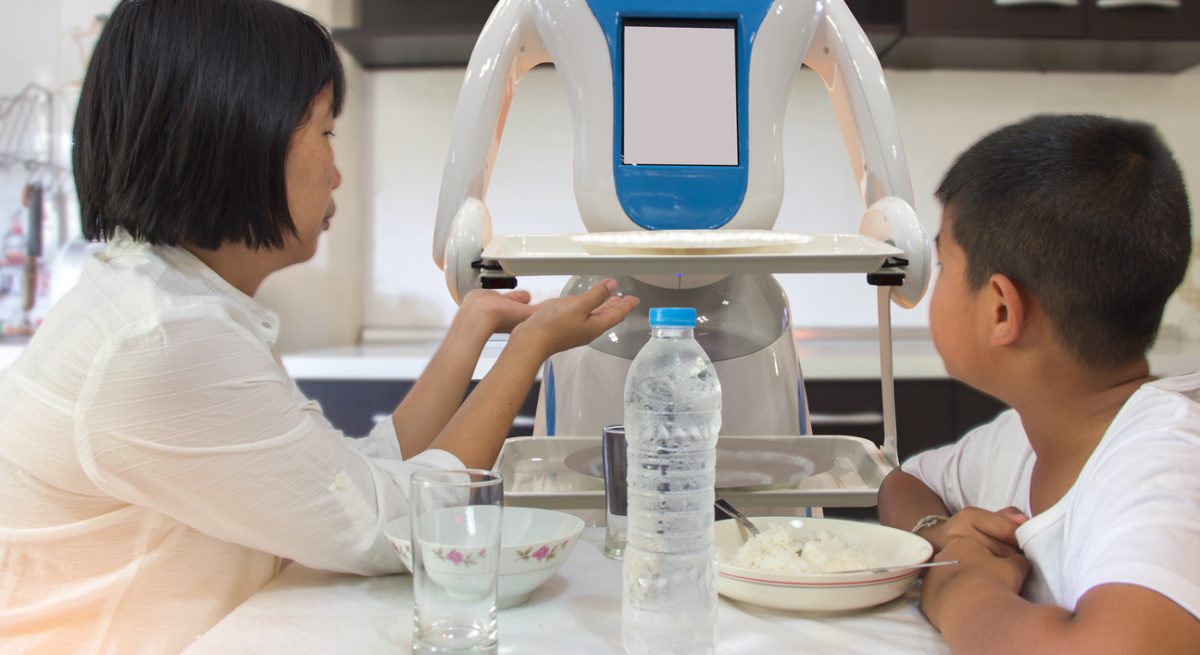How AI Will Save the Restaurant Industry
5 Min Read By Nandini Roy Choudhury
According to research by the National Restaurant Association Research and Knowledge Group, the restaurant industry will likely be drastically different by the year 2030. Within a decade, it could be possible for an individual to approach a drive-through in an autonomous vehicle, order through an AI-powered voice ordering assistant, and eat food that was prepared by robots.
One of the most obvious aspects of this interaction is that there is not a single human involved besides the consumer. These changes will cause massive implications for every aspect of the industry, most importantly for the workers and consumers.
Restaurants and food joints, once reliable venues for human interaction, will be important for the implementation of artificial intelligence (AI) technology. Some of the changes are already taking place in major companies like McDonald’s, which has implemented technology such as personalized automated drive-through menus that change depending on the time of day, weather, current restaurant traffic, and trending items.
This is just the beginning, and AI will transform every aspect of the industry. Some of the biggest disruptors will result from the increase in information technology, autonomous vehicles, automation and robotics in the kitchen, and AI chefs.
How AI Will Change Consumers Restaurant Experience
Voice Ordering
Twenty-seven percent of all people online now use voice search, and nearly 40 percent prefer voice search over their smartphones when searching for nearby restaurants. As voice assistants have become more popular, the tasks they can help users accomplish have become more complex and far-ranging.
Guests have been using virtual assistants to search for restaurants for a while now. But a new technology that's gaining popularity is voice ordering where guests can use their smart devices to place restaurant orders on the go or while multitasking.
But this technology has even more applications than just ordering on guests' personal devices. Voice ordering could be implemented at self-service kiosks or drive-throughs, allowing guests to place orders conversationally—and without touching anything, a great safety measure in the pandemic age.
Autonomous Vehicles and Drive-Thrus
Autonomous vehicles are one of the most successful and well-known creations that rely on AI. As self-driving cars increasingly take over the market, other industries will have to adapt. Drivers will have more time to eat, go through drive-throughs with the vehicles, use both hands when eating, and longer travel times will become more commonplace. All of this means that restaurants, especially fast-food places, will have to change how they operate.
Restaurants that interact with autonomous vehicles are setting themselves up to be better prepared for the future, as the technology will almost certainly spread everywhere. Software, such as AI assistants, will become more important in choosing destinations and interfacing directly with cars. Restaurants will likely increase their marketing presence in areas such as the screens in autonomous vehicles.
Before the use of self-driving passenger vehicles becomes common, it is likely that there will be the use of autonomous delivery vehicles. This will drastically change the way a restaurant delivers food. With the increased use of autonomous vehicles, drive-thrus will be forced to change in order to interact with the technology.
Kiosks that Personalize Customer Experiences
While ordering kiosks have become fairly common in a variety of restaurants, there are some eateries that are taking that experience a step further. Take KFC, for example, which is experimenting with kiosks with facial recognition technology that can recognize repeat visitors and tailor their experience based on their past orders and preferences.
While facial recognition might not be accessible for all restaurants, there are many ways you can use AI to help personalize the dining experience for your guests. Online ordering and digital marketing are two places where restaurants are more commonly collecting guest data, and then using that data to provide personalized service, from dish recommendations to targeted marketing.
How AI Will Change the Restaurants Operational Processes
Automation and Robotics in the Kitchen
Automation and robotics are going to become increasingly present in restaurants. As per a report by Future Market Insights (FMI), AI Assisted Robots will be hugely employed in various end use industries including the hoteling industry.
Technologies such as touchscreen ordering kiosks are already popping up and will continue to spread. As costs associated with automation become more affordable and robotics become more sophisticated, the kitchen will adopt the same trends. Automation is already causing process efficiency by automating repetitive tasks and this will inevitably spread throughout the workings of a restaurant. While chefs will work with the systems, tasks which are repetitive parts of food preparation will automated.
With the increasing presence of robotic equipment, kitchen staff are going to be required to possess non-traditional skillsets. Individuals working in a restaurant that utilizes automation and robotics will be expected to interact with the systems. These sophisticated systems will also increase the cost to operate over short term, however in long tail will benefit with process optimization and cost reduction.
AI to Reduce Food Wastage in the Restaurants
According to estimates, the restaurant industry is by itself responsible for approximately hundred million dollars a year of food waste.
One company, called Winnow, founded in London in 2013 has recently launched new AI-enabled technology called Winnow Vision to help reduce food wastage in restaurants, which uses a set of smart scales that are placed beneath a food waste bin. Using a touchscreen display, restaurant staff enter what type of food they have just thrown away into the system.
The technology uses a camera and state-of-the-art machine learning technology. Over time, it learns to recognize different foods that are being disposed of in the bin. It calculates the financial and environment cost of this discarded food on a cumulative basis. Restaurants can then adjust their food purchasing decisions accordingly, reducing their spending amounts as well as their contribution to food waste.
Integrated Inventory and Purchasing
One area of restaurant operations where AI can have a major impact is by integrating inventory and purchasing systems with your point of sale (POS systems). AI-enabled software can track historical inventory and purchasing data, looking for trends and making real-time recommendations for how many ingredients and supplies to buy.
Not only does this ensure the restaurant has enough inventory on hand to avoid running out of a popular dish, but it can help cut down on food waste by tailoring purchasing to only meet inventory needs, without buying excess that the restaurant won't be able to use before it expires.
Optimized Delivery Processes
Food delivery exploded in popularity during the COVID-19 pandemic, and that trend doesn't look like it's slowing down any time soon. That's why many restaurants are turning to AI technology to help them optimize their delivery processes.
AI can help delivery drivers find the best and fastest routes for making multiple deliveries in one trip, utilizing map data to avoid traffic and other hazards. AI can also keep guests in the loop about their orders—like how delivery platforms allow customers to follow along on a map, and send them texts when their order status is updated.
Data-Based Insights and Predictions
In 2019, McDonald's started using predictive AI technologies and forecasting orders made in its drive-thrus. By analysing historical data about what customers ordered and when, McDonald's stores were able to anticipate rushes and even predict what dish would be most popular during a given time of day. By anticipating orders, the stores using this technology were able to reduce wait times by 30 seconds on average, quite a feat, when you consider that drive-through ordering experiences typically only last a few minutes.
This kind of predictive technology can be used by restaurants in so many ways: to manage inventory, staffing, menu pricing, and more.
Automated Marketing and Remarketing
One place where most restaurants can implement AI today is in their digital marketing plans. There are many tools available now that use automation to send out marketing emails, social media posts, and targeted ads to the right people at the right times to maximize views, click-through rates, and more.
AI marketing can also be used to retarget recent visitors to your restaurant, encouraging them to become repeat guests. It can help identify promotions that might help you upsell guests. All you need is the right automated marketing tools.
AI in Restaurants Is Here to Stay
While AI might seem like an intimidating subject to many less tech-savvy restaurateurs, the bottom line is that it's earned its place in the restaurant industry's future. AI is here to stay, and along with it, many benefits for independent restaurants that embrace the trend.


